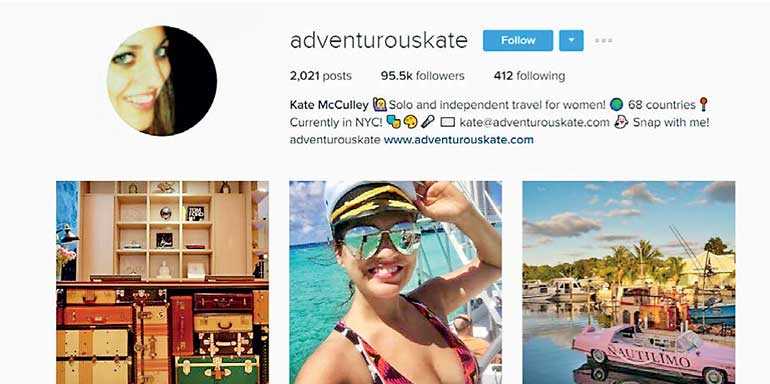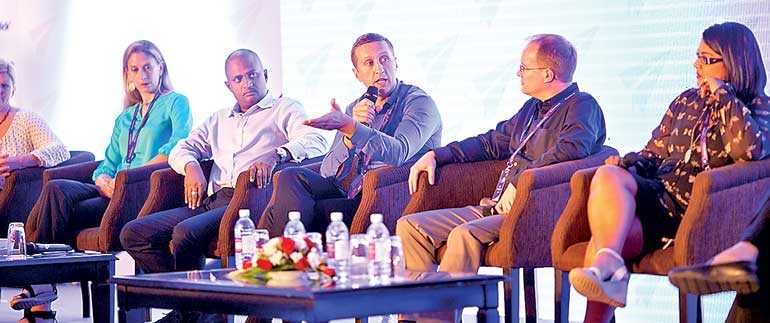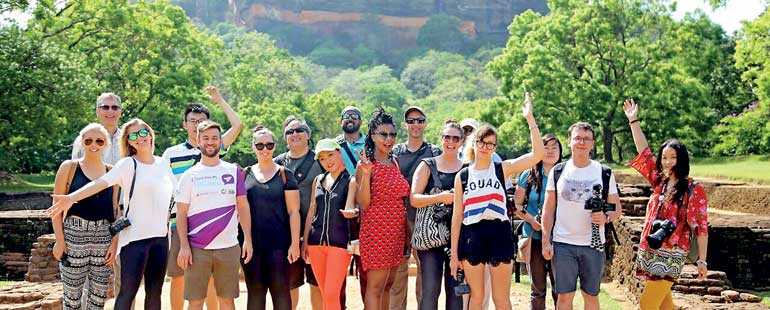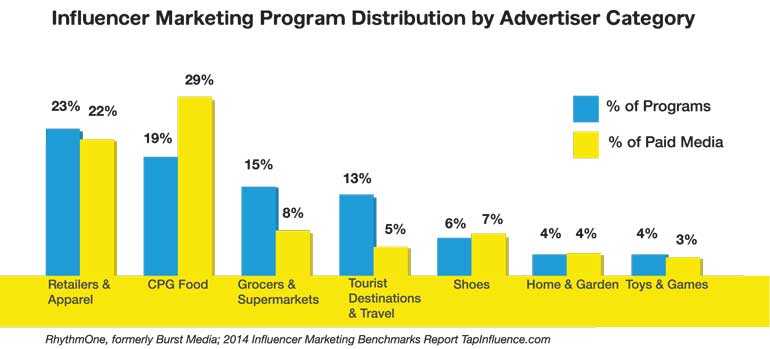Friday Dec 12, 2025
Friday Dec 12, 2025
Monday, 29 October 2018 00:10 - - {{hitsCtrl.values.hits}}

Influencer marketing is the idea of partnering with social content creators, those with key audiences on platforms like blogs, Facebook, Twitter, Pinterest, YouTube, Instagram, and Vine, to help satisfy the consumer’s insatiable appetite for stories and opinions about products they buy. The exploding industry is attracting millions of dollars from brands looking for solutions that help them scale the creation and distribution of trusted consumer content. 
In the 2012 edition Volo (2012) describes a new, decentralised communication paradigm based on Web 2.0 that allows brands to directly and personally connect to customers. While this is still the case, this social media-supported marketer-consumer conversation space has become incredibly crowded. Both marketer and consumer messages might be spread or contested by other consumers or traditional media. In this complex social media-based buzz echoverse (Hewett, Rand, Rust & van Heerde, 2016), it is ever more important for brands to be able to amplify their messages.
In addition, platforms like Facebook have developed their display algorithm in a way that makes it increasingly difficult for marketers to organically appear in consumers’ social media feeds. At the same time, consumers are adopting ad blocking software at growing rates while also feeling ever more bombarded with information. This fuels a need for information filters and encourages the emergence of a traditional two-step flow of information (Katz, 1957), with opinion leaders pre-processing information and spreading messages to a wider, dedicated audience.
These opinion leaders are trusted individuals who offer advice and exercise influence over the opinion of others. In the social media context, these opinion leaders are usually called key opinion leaders (especially in China), or simply influencers.
Marketers can take advantage of these influencers and their ability to reach large/targeted audiences with engaging contents by building mutually beneficial relationships with social media influencers that align with their brands. When done right, such influencer marketing strategies can lead to much better returns on investment than the use of branded content or straight-forward advertising.

Kirsten Rich of The Blonde Abroad with Dileep Mudadeniya and Dave and Deb of Planet D
Influencer marketing practices
Influencer marketing is still an emerging practice. Nanji (2017) reports that many marketers are still experimenting with influencer marketing and that only 24% have ongoing influencer programs while a mere 5% have integrated influencers across all marketing activities. One of the reasons is that measuring the return on investment of an influencer campaign remains difficult.
eMarketer (2015) finds that the main challenges of influencer marketing are 1) identifying the right influencers; 2) finding the right engagement tactics; and 3) measuring the performance of an influencer campaign. Identifying the right influencers is often achieved through the use of tools like blog search engines (e.g. blekko.com and socialmention.com), while Klout, Kred and Peer Index are examples of tools that rank social media influencers based on their ‘social capital’ and activity level.
In the age of social media, consumers move from being fans to being producers of promotional content for brands, and from occasional endorsers to micro-celebrity-seeking social media influencers (Hearn & Schoenhoff, 2016). Some of these micro- and meso-celebrities have.

Melvin Boecher of Travel Dudes and Elizabeth Carlson of Young Adventuress
Who are social media influencers?
Influencers are individuals who have the power to affect decisions of others because of their (real or perceived) authority, knowledge, position, or relationship (Businessdictionary.com, 2017). Others have defined influencers as individuals who have an active following and can move their followers to take action (MarketingProfs.com, 2016).
Consumers today avoid messages. While celebrities continue to be influential in the social media realm, social media also produced so-called grassroots influencers or micro-celebrities who were able to create a following through their engaging and relevant content. McQuarrie, Miller and Phillips (2013) refer to this ability of regular social media users to amass enough social capital to reach a mass audience as the ‘mega- phone effect’ of social media. In contrast to mainstream celebrities who create celebrity value through exclusiveness, social media micro-celebrities establish their value through authenticity and connectedness (Jerslev, 2016). Hearn and Schoenhoff (2016) describe social media influencers as working to “generate a form of ‘celebrity’ capital by cultivating as much attention as possible and crafting an authentic ‘personal brand’ via social networks, which can subsequently be used by companies and advertisers for consumer outreach” (p. 194). Some of these social media stars end up becoming mainstream celebrities (see for example the Chinese backpacker and blogger T40C described by Shao and Gretzel, 2011). Both celebrities and micro-celebrities are increasingly used by marketers to spread messages to targeted audiences on social media; this practice is referred to as influencer marketing, though the traditional media (TV, print and radio) and the messages through them rank low on trust. Peer-created social content or user-generated content is trusted more than other types of media. Through social media consumers have gotten closer to the celebrities and influencers. Over time they have formed a relationship and consumers trust the influencers.

What influential means on social media and how it can be identified is the one-million-dollar question of influencer marketing. Inkybee (2016) proposes that the most important metrics of influence are: Size of audience, how often they post, level of engagement and search engine optimisation-based metrics. Specifically looking at bloggers, Solis (2008) lists traffic to the blog, links back to the blog, amount of subscribers to the feed and grasp of the industry as important measures that determine influence.
Radey (2015), however, suggests that reach might not be as important as relevance and passion, and that real influence is not a matter of social media followers, as they can easily be amassed or even faked. Similarly, Krasniak (2016) reports that authenticity matters the most, while Hearn and Schoenhoff (2016) stress alignment with the brand. De Veirman, Cauberghe and Hudders (2016) report that high numbers of followers increase popularity perceptions and likeability of an influencer but might also negatively influence perceptions of the product’s exclusivity.
eMarketer (2015) finds that most influencer marketers select influencers based on their social profile, verified traffic data and demographics and that page rank and search optimisation standing are less important selection criteria. What is surprising is that influencers have become almost as important as traditional word-of-mouth from family and friends, with 56% of Twitter users reporting that they rely on recommendations from friends and 49% reporting that they rely on recommendations from influencers (Swant, 2016). Influencer marketing goes beyond encouraging simple endorsements or message sharing by influencers. Krasniak (2016) lists ongoing brand ambassadorship, product reviews, brand mentions, event coverage, sponsored content and affiliate links as the most important and effective influencer marketing tactics currently used by marketers. These tactics are applied to support various marketing areas. eMarketer (2015) reports that the Top 3 areas for which marketers employ influencers are content promotion, product launch and content creation, followed by other areas such as event management, corporate communications, search engine optimisation and crisis management.

Panel discussion at Cinnamon TBC Asia 2016
Influencers’ impact on the brand
Brands have always had a focus on targeting their consumers’ wants and needs. The image a brand gains from its social media influencers helps build direct relationships with its key consumers and encourages brand loyalty. While a brand does not have total control over its online conversation, the direct voice of an influencer and trust that consumers have for this individual is instilled in the brand through the two-way conversation that is established for the product via social media outlets (Booth and Matic, 3).
Theories behind influencer communication
Bandura, the social-science theorist responsible for much of our understanding of how people react in social situations, wrote, “In the social learning system, new patterns of behaviour can be acquired through direct experience or by observing the behaviours of others (Bandura, 3). This explanation can help one understand why influencers are so ‘influential’.
Bandura explained, “On the basis of informative feedback, they (consumers) develop thoughts or hypotheses about the types of behaviour most likely to succeed. These hypotheses then serve as guides for future actions.” (3). To put this into simpler terms, people learn from example, and influencers lead by example for those who ‘follow’ them. By observing examples through social media, people are more likely to adopt the behaviours exhibited by the influencer (Forbes, 2016). Companies are using their resources via social media influencers in hopes that the experience that a consumer has with an influencer allows the behaviour of the influencer to be adopted, that is, copied by the consumer (Forbes).

Influencer authenticity
For social media influencer’s whose focus is on lifestyle branding, authenticity is key. This study defined authenticity as the influencer being genuine, honest, and open with her followers. Authenticity allows an influencer to relate with followers on a new level and aids in building a relationship between followers and brands. Creating content for YouTube that is authentic gives influencers the opportunity to share their personal thoughts, opinions, and style with their followers who may then take their lead.
In Fink’s video, ‘5 Days of New Experiences’, she was challenged, with her friend Ashley, to try something new every day for a week. Since this video is also an advertisement for Carnival Cruise Line, Fink’s new experiences take place on a five-day carnival cruise. The company attempts to establish itself as a young, vibrant, and friendly cruise line. As a result, Carnival chose to partner with Fink, an individual who is authentic and relatable and shows off those similar personality traits in her videos.
TBC Asia 2018 – only influencer marketing conference in South Asia
Cinnamon Hotels and Resorts, is hosting the third Travel Bloggers’ Conference and Award Ceremony in Colombo on 30 October. Keeping in line with the evolving landscape of how digital influencers impact on industries and business, Cinnamon has put together a content rich program delivered by some of the leading global experts from Google, CNN, Expedia and Ykone. The conference theme this year is ‘Agents of Change: Creating transformational Digital Content’ and it will be a platform for brands to understand how a cost effective influencer strategy should be developed. This year’s conference brings down two of the best world authorities in influencer marketing Shane Barker, a digital strategist speaking about why influencer marketing and e-commerce are a perfect fit and Olivier Billon, CEO of Ykone speaking on using Influencer marketing to create and amplify story-telling around a product.
TBCasia conference brings together 60 of the best travel bloggers from across the world, 300 travel industry leaders in Sri Lanka and from the region, along with global experts on tourism. The event is held in exclusive partnership with the Professional Travel Bloggers Association.

Conclusion
Social media influencers who promote a lifestyle brand are most successful interacting with consumers when they are authentic, confident, and interactive in their content. While this research focused on lifestyle branding, the same likely holds true for many products that public relations agencies and marketers promote, from automobiles to electronics to household products.
The use of social media influencer marketing in lifestyle public relations initiatives has broken the wall between the consumer, the brand, and followers through social media content. Before the rise of social media influencers, advertising to brand consumers was one-sided. Before the days of social media, a consumer could only see a product through print advertisements, billboards, radio ads, and television commercials. Today, a consumer can interact with a product through social media. Watching a trusted source, such as Fink, use a product allows consumers to feel as if they are making a more informed decision when making a purchase.
Through research, it is evident that social media influencer marketing has, in fact, changed the way brands interact with consumers in a positive way. The success that brands may expect is due to this two-way interactive public relations tactic and helps to explain why social media influencer marketing is one of the biggest trends of 2018/9 and is trusted by their readers.
“An influencer outreach program is quickly becoming indispensable to the modern digital marketing strategy. Influencers are more valuable to brands now than they’ve ever been for their ability to deliver on social chatter, earned media, and action.”
–Tessa Wegert, ClickZ (RhythmOne, formerly Burst Media)
A 2014 study conducted by RhythmOne (formerly Burst Media) found that on average, marketers who implemented an Influencer Marketing program in 2014 received $6.85 in earned media value for every $1.00 of paid media.
What do influencers have that brands do not?
1. Influencers are trusted more than brands
2. Influencers produce more earned media
3. Influencers reach a more targeted audience
4. Social influencers distribute more content across the web
(The writer is the founder of Centre for Research and Sustainability Studies in Tourism. Currently he is the Head of Brand Marketing – Cinnamon Hotels and Resorts, CEO of Cinnamon Life Mall and Vice President – John Keells Group. He is also a member of the national tourism task force.)